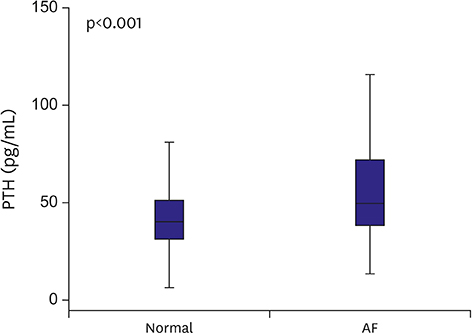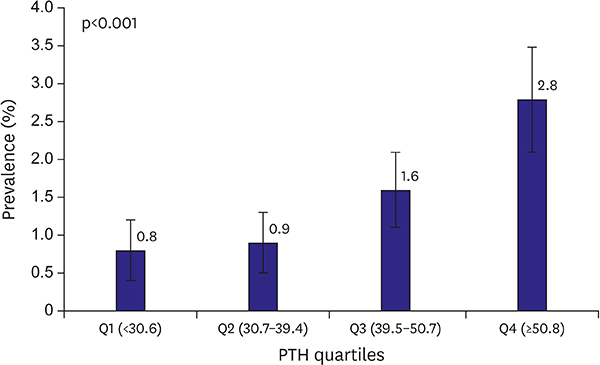Korean Circ J.
2018 Feb;48(2):159-167. 10.4070/kcj.2017.0187.
Association between Serum Parathyroid Hormone Levels and the Prevalence of Atrial Fibrillation: the Dong-gu Study
- Affiliations
-
- 1Department of Cardiovascular Medicine, Chonnam National University Hospital, Gwangju, Korea. mdhwp@chol.com
- 2Department of Preventive Medicine, Chonnam National University Medical School, Hwasun, Korea. mhshinx@paran.com
- 3Department of Preventive Medicine & Institute of Wonkwang Medical Science, Wonkwang University School of Medicine, Iksan, Korea.
- KMID: 2403163
- DOI: http://doi.org/10.4070/kcj.2017.0187
Abstract
- BACKGROUND AND OBJECTIVES
We aimed to investigate the association between serum parathyroid hormone (PTH) levels and the prevalence of atrial fibrillation (AF) in a population based study.
METHODS
This study included a total of 9,007 community-dwelling Koreans aged 50 years and over who were enrolled in the Dong-gu study from 2007 to 2010. Electrocardiograms were recorded from the subjects using the HP-PageWriter 200 M1771A. All potential cases of AF were determined by 2 cardiologists. PTH concentration was measured by a chemiluminescent microparticle immunoassay. Multiple logistic regression analysis was used to evaluate the relationship between the quartiles of PTH and AF, adjusting for potential confounders.
RESULTS
The prevalence of AF was 2.41% in males and 0.9% in females and increased with advanced age in both genders. The median and interquartile range (IQR) of serum PTH was 39.5 pg/mL (IQR, 30.6-50.8), which was significantly higher in patients with AF than in patients without AF (p < 0.001). The prevalence of AF increased with increasing PTH quartile (0.8%, 0.9%, 1.6%, and 2.8% in the lowest, second, third, and highest PTH quartiles, respectively; p < 0.001). Multivariable logistic analysis adjusted for cardiovascular risk factors showed the highest quartile of serum PTH levels was associated with a higher prevalence of AF than the lowest quartile (odds ratio, 3.34; 95% confidence interval, 1.93-5.78).
CONCLUSIONS
Higher levels of serum PTH were associated with higher prevalence of AF. Further studies are needed to determine whether this association is present in other populations and in a prospective study setting.
Keyword
MeSH Terms
Figure
Cited by 1 articles
-
Current Understanding on Mechanisms Leading to Atrial Fibrillation
Myung-Jin Cha
Korean Circ J. 2018;48(2):170-172. doi: 10.4070/kcj.2018.0008.
Reference
-
1. Kirchhof P, Benussi S, Kotecha D, et al. 2016 ESC guidelines for the management of atrial fibrillation developed in collaboration with EACTS. Eur Heart J. 2016; 37:2893–2962.2. Rienstra M, Lubitz SA, Zhang ML, Cooper RR, Ellinor PT. Elevation of parathyroid hormone levels in atrial fibrillation. J Am Coll Cardiol. 2011; 57:2542–2543.
Article3. Shor R, Tilis Y, Boaz M, Matas Z, Fux A, Halabe A. Serum parathyroid hormone-related protein levels before and after paroxysmal atrial fibrillation. Am J Emerg Med. 2008; 26:361–363.
Article4. Wannamethee SG, Welsh P, Papacosta O, Lennon L, Whincup PH, Sattar N. Elevated parathyroid hormone, but not vitamin D deficiency, is associated with increased risk of heart failure in older men with and without cardiovascular disease. Circ Heart Fail. 2014; 7:732–739.
Article5. Lopez FL, Agarwal SK, Grams ME, et al. Relation of serum phosphorus levels to the incidence of atrial fibrillation (from the Atherosclerosis Risk In Communities [ARIC] study). Am J Cardiol. 2013; 111:857–862.
Article6. Altay H, Zorlu A, Binici S, et al. Relation of serum parathyroid hormone level to severity of heart failure. Am J Cardiol. 2012; 109:252–256.
Article7. Pilz S, Tomaschitz A, Drechsler C, et al. Parathyroid hormone level is associated with mortality and cardiovascular events in patients undergoing coronary angiography. Eur Heart J. 2010; 31:1591–1598.
Article8. van Ballegooijen AJ, Visser M, Kestenbaum B, et al. Relation of vitamin D and parathyroid hormone to cardiac biomarkers and to left ventricular mass (from the Cardiovascular Health Study). Am J Cardiol. 2013; 111:418–424.
Article9. Kweon SS, Shin MH, Jeong SK, et al. Cohort profile: the Namwon Study and the Dong-gu Study. Int J Epidemiol. 2014; 43:558–567.
Article10. Ogino K, Burkhoff D, Bilezikian JP. The hemodynamic basis for the cardiac effects of parathyroid hormone (PTH) and PTH-related protein. Endocrinology. 1995; 136:3024–3030.
Article11. Andersson P, Rydberg E, Willenheimer R. Primary hyperparathyroidism and heart disease--a review. Eur Heart J. 2004; 25:1776–1787.12. Saleh FN, Schirmer H, Sundsfjord J, Jorde R. Parathyroid hormone and left ventricular hypertrophy. Eur Heart J. 2003; 24:2054–2060.
Article13. Grant FD, Mandel SJ, Brown EM, Williams GH, Seely EW. Interrelationships between the renin-angiotensin-aldosterone and calcium homeostatic systems. J Clin Endocrinol Metab. 1992; 75:988–992.
Article14. Snijder MB, Lips P, Seidell JC, et al. Vitamin D status and parathyroid hormone levels in relation to blood pressure: a population-based study in older men and women. J Intern Med. 2007; 261:558–565.
Article15. Jorde R, Svartberg J, Sundsfjord J. Serum parathyroid hormone as a predictor of increase in systolic blood pressure in men. J Hypertens. 2005; 23:1639–1644.
Article16. Watson T, Shantsila E, Lip GY. Mechanisms of thrombogenesis in atrial fibrillation: Virchow’s triad revisited. Lancet. 2009; 373:155–166.
Article17. Hara M, Liu YM, Zhen L, et al. Positive chronotropic actions of parathyroid hormone and parathyroid hormone-related peptide are associated with increases in the current, I(f), and the slope of the pacemaker potential. Circulation. 1997; 96:3704–3709.18. McCarty MF, Barroso-Aranda J, Contreras F. Can moderate elevations of parathyroid hormone acutely increase risk for ischemic cardiac arrhythmias? Med Hypotheses. 2009; 72:581–583.
Article19. Kestenbaum B, Katz R, de Boer I, et al. Vitamin D, parathyroid hormone, and cardiovascular events among older adults. J Am Coll Cardiol. 2011; 58:1433–1441.
Article20. Anderson JL, Vanwoerkom RC, Horne BD, et al. Parathyroid hormone, vitamin D, renal dysfunction, and cardiovascular disease: dependent or independent risk factors? Am Heart J. 2011; 162:331–339.e2.
Article
- Full Text Links
- Actions
-
Cited
- CITED
-
- Close
- Share
- Similar articles
-
- Clinical significance of serum TSH in euthyroid patients with paroxysmal atrial fibrillation
- A Study on Serum and Urinary Calcium, Inorganic Phosphorus and Serum Parathyroid Hormone Levels in Patients with Renal Stone
- Study on Serum and Urinary Calcium Level and Serum Parathyroid Hormone in Patients with Urinary Stone
- The Predictive Value of Serum Parathyroid Hormone Levels for the Occurrence of Hypocalcemia Following Total Thyroidectomy
- A study on Serum Calcium, Phosphorus, Magnesium and Parathyroid Hormone Levels of Cord Blood in Newborn



